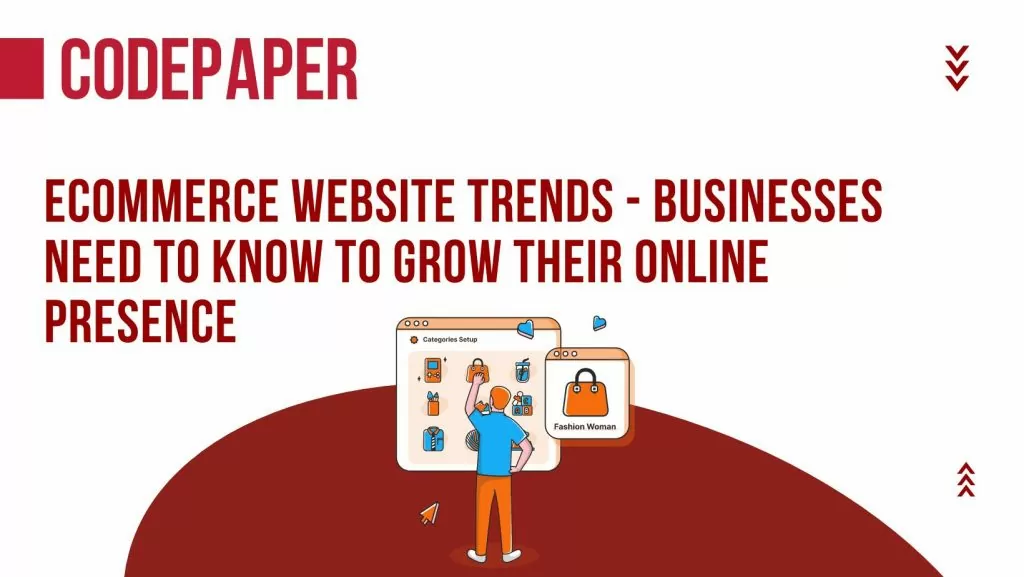
In today’s digital age, eCommerce websites have become a vital component for businesses to reach their customers and grow their online presence. With the increasing number of consumers turning to online shopping, it is crucial for businesses to stay up-to-date with the latest eCommerce website trends to remain competitive in the market. By implementing these trends, businesses can enhance their online shopping experience, increase customer engagement, and ultimately drive more sales. In this article, we will discuss the eCommerce website trends that businesses need to know to grow their online presence. These trends include personalization, mobile optimization, social media integration, voice search, augmented reality, and customer reviews/user-generated content. By incorporating these trends into their eCommerce strategy, businesses can stay ahead of the curve and provide their customers with a seamless and engaging shopping experience.
eCommerce websites have become increasingly important for businesses in today’s digital age. With the rise of online shopping, businesses have recognized the need to establish an online presence to reach a wider audience and drive sales. eCommerce websites provide businesses with the opportunity to sell their products or services online, making them accessible to customers from anywhere in the world.
Moreover, eCommerce websites offer businesses several advantages over traditional brick-and-mortar stores. For example, eCommerce websites allow businesses to operate 24/7, enabling customers to shop at any time, regardless of their location. This increases the potential for sales and revenue generation.
In addition, eCommerce websites provide businesses with valuable insights into their customers’ behaviors and preferences through data analytics. This information can be used to optimize the customer experience and tailor marketing strategies to target specific customer segments.
Furthermore, eCommerce websites offer businesses the flexibility to test new products or services without committing to a significant investment in physical infrastructure or inventory. This enables businesses to experiment with different product offerings and pricing strategies to determine what resonates with their customers.
Overall, eCommerce websites have become a crucial component for businesses to establish an online presence, expand their reach, and drive sales. As technology continues to evolve, eCommerce websites will continue to play a vital role in the success of businesses of all sizes and industries.
The eCommerce industry refers to the buying and selling of products or services online. It has experienced significant growth over the past decade, driven by advances in technology and changes in consumer behavior.
According to eMarketer, global eCommerce sales are projected to reach $6.38 trillion by 2024. This growth is fueled by increasing internet penetration rates, rising mobile phone usage, and the convenience and accessibility of online shopping.
The eCommerce industry is highly diverse, encompassing a range of businesses, from small startups to multinational corporations. It spans a variety of sectors, including retail, fashion, electronics, groceries, and more.
In addition, the eCommerce industry has given rise to new business models, such as drop shipping, subscription-based services, and online marketplaces. These models have disrupted traditional supply chains and transformed the way businesses operate.
However, the eCommerce industry also faces several challenges, such as cybersecurity threats, data privacy concerns, and the need to provide a seamless and secure shopping experience. As the industry continues to evolve, businesses must adapt to changing consumer needs and preferences and stay up-to-date with the latest eCommerce trends to remain competitive.
Personalization

Personalization is one of the key eCommerce website trends that businesses need to know to grow their online presence. It involves tailoring the shopping experience to the individual needs and preferences of each customer. By providing personalized experiences, businesses can increase customer engagement, loyalty, and ultimately, drive more sales.
Personalization has become increasingly important in eCommerce as customers seek more relevant and personalized shopping experiences. Customers are more likely to engage with businesses that offer personalized experiences that cater to their specific needs and preferences. This can lead to increased customer satisfaction and loyalty, as well as higher conversion rates and revenue growth.
There are several personalization tactics that businesses can use to enhance the eCommerce shopping experience, such as:
- Product recommendations based on past purchases or browsing behavior.
- Personalized email campaigns that address the customer by name and offer relevant product recommendations.
- Dynamic pricing that adjusts based on customer behavior or preferences.
- Personalized landing pages that show content tailored to the customer’s interests or location.
- User-generated content such as ratings and reviews that help customers make more informed purchase decisions.
Personalization offers several benefits for businesses, including:
Increased customer engagement and loyalty:
By providing personalized experiences, businesses can increase customer satisfaction and loyalty, leading to repeat purchases and word-of-mouth recommendations.
Higher conversion rates:
Personalization can help businesses provide more relevant and targeted product recommendations, leading to higher conversion rates and revenue growth.
Improved customer insights:
Personalization tactics can provide businesses with valuable customer data, such as purchase behavior, preferences, and feedback. This information can be used to optimize marketing strategies and product offerings.
Competitive advantage:
By offering personalized experiences, businesses can differentiate themselves from competitors and build a strong brand identity.
Mobile Optimization

Mobile optimization is another critical eCommerce website trend that businesses need to know to grow their online presence. With the increasing use of smartphones and tablets, it is essential for businesses to optimize their eCommerce websites for mobile devices to provide a seamless and user-friendly shopping experience.
Mobile optimization is essential for eCommerce businesses as it allows them to reach a wider audience and provide a better user experience. Customers expect to be able to shop on their mobile devices, and if a website is not optimized for mobile, they are likely to leave and look for another option. A mobile-optimized eCommerce website can also improve search engine rankings and drive more traffic to the site.
The prevalence of mobile shopping continues to grow, with more than half of all eCommerce transactions now taking place on mobile devices. According to Statista, mobile eCommerce sales are projected to reach $3.56 trillion by 2021, and a recent survey by Google found that 67% of online shoppers were more likely to buy from a mobile-friendly site.
There are several tactics that businesses can use to optimize their eCommerce websites for mobile devices, such as:
- Responsive design: This ensures that the website layout adapts to the screen size of the device being used, providing a seamless user experience.
- Simplified navigation: Mobile users want to find what they are looking for quickly and easily, so businesses should simplify navigation and make it easy to find products and information.
- Fast load times: Mobile users expect fast load times, so businesses should optimize images and other content to ensure the website loads quickly.
- Mobile payment options: Offering mobile payment options such as Apple Pay or Google Wallet can make the checkout process faster and more convenient for customers.
- Push notifications: Sending push notifications to customers who have downloaded a mobile app can help businesses stay top of mind and drive more sales.
mobile optimization is a crucial eCommerce website trend that businesses need to know to grow their online presence. With the prevalence of mobile shopping continuing to grow, businesses that optimize their websites for mobile devices can reach a wider audience, provide a better user experience, and drive more sales.
Social Media Integration

Social media integration is a vital eCommerce website trend that businesses need to know to grow their online presence. It involves incorporating social media platforms such as Facebook, Instagram, Twitter, and Pinterest into eCommerce websites to increase engagement and drive sales.
Social media integration is crucial in eCommerce because it allows businesses to connect with customers on a more personal level. By integrating social media into their eCommerce websites, businesses can create a seamless experience for customers to browse products, share their purchases, and leave reviews. It also enables businesses to leverage social media’s massive reach and target specific audiences to drive traffic and increase conversions.
There are numerous benefits of integrating social media into eCommerce websites, including:
- Increased customer engagement: Social media integration provides a platform for customers to interact with the business and share their experiences with others, leading to increased engagement and brand loyalty.
- Boost in sales: By integrating social media into eCommerce websites, businesses can increase visibility, drive traffic, and ultimately increase sales.
- Enhanced customer experience: Social media integration enables customers to view products, read reviews, and make purchases without leaving the social media platform, leading to a more seamless and convenient shopping experience.
- Improved search engine rankings: Social media integration can improve search engine rankings, as social media shares and interactions can contribute to a website’s authority and relevance.
There are several tactics businesses can use to integrate social media into their eCommerce websites, such as:
Social media sharing buttons:
Including social media sharing buttons on product pages and other areas of the website can encourage customers to share products and content with their followers.
User-generated content:
Leveraging user-generated content from social media platforms, such as customer photos and reviews, can increase engagement and build trust with potential customers.
Social media advertising:
Businesses can use social media advertising to target specific audiences and drive traffic to their eCommerce website.
Social login:
Allowing customers to log in or register using their social media accounts can simplify the registration process and improve the customer experience.
social media integration is a crucial eCommerce website trend that businesses need to know to grow their online presence. By integrating social media platforms into eCommerce websites, businesses can increase customer engagement, boost sales, enhance the customer experience, and improve search engine rankings.
Voice Search

Voice search is a rapidly growing trend in eCommerce that businesses need to know to grow their online presence. With the increasing popularity of smart speakers and voice assistants, more and more customers are using voice search to browse and purchase products.
According to a study by OC&C Strategy Consultants, voice commerce is expected to reach $40 billion in the United States and $5 billion in the United Kingdom by 2022. The rise of voice search is due to the increasing availability of smart speakers and voice assistants, such as Amazon Echo and Google Home, as well as the convenience and speed of using voice to search and purchase products.
Optimizing eCommerce websites for voice search is essential because it can improve the customer experience and drive sales. Voice search requires a different approach to traditional search engine optimization (SEO) because customers use natural language and long-tail keywords when speaking, rather than short keywords used in typed searches. Therefore, eCommerce websites need to be optimized for conversational queries and long-tail keywords to rank well in voice search results.
There are several tactics businesses can use to optimize their eCommerce websites for voice search, such as:
Use conversational language:
When creating content for eCommerce websites, use conversational language to mimic how customers speak when using voice search. This includes using long-tail keywords and natural language phrases.
Optimize for featured snippets:
Featured snippets appear at the top of search engine results and are read aloud by voice assistants. By optimizing content for featured snippets, eCommerce websites can increase their chances of being read aloud in voice search results.
Improve website speed:
Website speed is crucial in voice search because customers expect quick results. By optimizing website speed, eCommerce websites can improve the customer experience and increase the chances of ranking well in voice search results.
Use structured data:
Structured data provides search engines with additional information about the content on eCommerce websites. By using structured data, eCommerce websites can help search engines understand the content better and improve the chances of ranking well in voice search results.
optimizing eCommerce websites for voice search is a crucial trend that businesses need to know to grow their online presence. By using conversational language, optimizing for featured snippets, improving website speed, and using structured data, eCommerce websites can improve the customer experience and drive sales through voice search.
Augmented Reality (AR) and Virtual Reality (VR)

Augmented Reality (AR) and Virtual Reality (VR) are becoming increasingly popular in eCommerce, allowing businesses to provide customers with immersive shopping experiences that go beyond traditional 2D product images.
AR and VR are technologies that enable businesses to create virtual experiences for customers. AR overlays digital images onto the real world, while VR creates a fully immersive digital environment. In eCommerce, businesses can use AR and VR to enable customers to see products in 3D, try them on virtually, and even see how they would look in their home environment.
Using AR and VR in eCommerce can provide several benefits for businesses, including:
Enhanced customer engagement:
AR and VR provide customers with immersive and interactive shopping experiences, which can enhance customer engagement and make the shopping experience more enjoyable.
Increased customer confidence:
By allowing customers to see products in 3D and try them on virtually, businesses can increase customer confidence in their purchases, reducing the likelihood of returns.
Reduced costs:
AR and VR can help businesses reduce costs associated with product photography and physical store displays, as they can create virtual environments and product images that can be reused across multiple channels.
Several businesses are already using AR and VR in eCommerce to provide customers with immersive shopping experiences. For example:
IKEA:
The IKEA Place app allows customers to see how furniture would look in their home environment using AR technology.
Sephora:
The Sephora Virtual Artist app uses AR technology to allow customers to try on makeup virtually.
Adidas:
The Adidas Confirmed app uses AR technology to allow customers to see how limited edition sneakers would look on their feet.
AR and VR in eCommerce can provide businesses with several benefits, including enhanced customer engagement, increased customer confidence, and reduced costs. By leveraging these technologies, businesses can provide customers with immersive and interactive shopping experiences that go beyond traditional 2D product images, ultimately driving sales and improving customer satisfaction.
Customer Reviews & User-Generated Content (UGC)
In eCommerce, customer reviews and user-generated content (UGC) are becoming increasingly important for businesses looking to grow their online presence. They provide social proof to potential customers, increase trust in the brand, and help businesses stand out from competitors.
Customer reviews and UGC are essential for eCommerce businesses because they provide a voice for customers, allowing them to share their experiences with others. This type of content provides valuable insights into the products and services that businesses offer, helping potential customers make informed purchase decisions.
By featuring customer reviews and UGC, businesses can provide several benefits, including:
Increased credibility:
Customer reviews and UGC provide social proof, which can increase credibility and trust in the brand.
Higher conversion rates:
Potential customers are more likely to make a purchase when they see positive reviews from other customers.
Improved search engine ranking:
User-generated content can help businesses improve their search engine ranking by increasing the amount of relevant and engaging content on their website.
Businesses can use several tactics to feature customer reviews and UGC, including:
Product reviews:
Adding a product review section to each product page, allowing customers to share their thoughts and experiences with the product.
Social media engagement:
Encouraging customers to share their experiences on social media and then sharing that content on the business’s website.
User-generated content campaigns:
Launching campaigns that encourage customers to create and share UGC, such as photos or videos featuring the business’s products.
customer reviews and user-generated content are essential for eCommerce businesses looking to grow their online presence. By featuring this content on their website and social media channels, businesses can increase credibility, improve conversion rates, and improve their search engine ranking.
Staying Up-To-Date
staying up-to-date with eCommerce trends is essential for businesses looking to grow their online presence. Personalization, mobile optimization, social media integration, voice search, augmented reality, virtual reality, and customer reviews and user-generated content are all trends that businesses should be aware of and consider implementing.
Personalization allows businesses to create a unique shopping experience for customers, leading to increased engagement and loyalty.
Mobile optimization ensures that businesses are meeting the demands of the ever-growing number of consumers who shop on mobile devices.
Social media integration allows businesses to reach new customers and increase engagement with existing customers.
Voice search optimization ensures that businesses are optimizing for the growing number of consumers who use voice assistants to shop online.
Augmented reality and virtual reality allow businesses to create immersive shopping experiences for customers, improving engagement and increasing sales.
Finally, customer reviews and user-generated content provide social proof, which is essential in building trust and credibility with potential customers.
As for the future of eCommerce, we can expect continued growth and innovation in the industry. With new technologies emerging and changing consumer behaviors, businesses that stay ahead of the trends will be best positioned to succeed.
In conclusion, businesses should take action to implement these eCommerce trends in order to remain competitive and grow their online presence. By doing so, they can create a unique and engaging shopping experience for their customers, increase brand awareness and loyalty, and ultimately drive sales and revenue.



